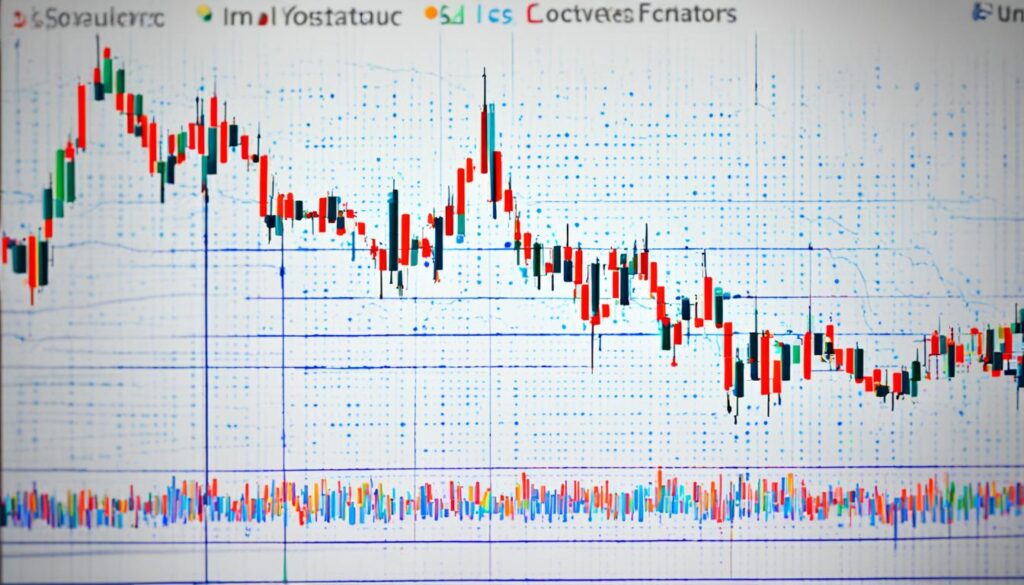As a savvy trader, staying ahead of the market is crucial for success. That’s why TradingView has become the go-to platform for traders looking to enhance their market analysis. With a vast selection of indicators, TradingView offers a comprehensive list that can help you make informed trading decisions and stay on top of market trends.
Key Takeaways:
- TradingView provides a wide range of indicators for traders to enhance their market analysis.
- Indicators such as moving averages, MACD, and Parabolic SAR are essential for trend following strategies.
- Oscillators like RSI, Stochastic, and MACD-Histogram help identify overbought and oversold conditions.
- Volume and volatility indicators such as Bollinger Bands, Volume Profile, and Average True Range provide insights into market activity.
- By leveraging TradingView indicators, savvy traders can gain valuable insights into market trends and make more informed trading decisions.
Trend Following Indicators
When it comes to trading, staying in tune with market trends is crucial for success. That’s where trend following indicators come into play. These indicators help traders identify and follow the prevailing market trends, providing valuable insights for decision-making. TradingView offers a diverse range of trend following indicators that can enhance your trading strategy.
Moving averages are one of the most commonly used trend following indicators. They help traders determine the direction of a trend by smoothing out price fluctuations over a specific time period. Whether it’s a simple moving average (SMA) or an exponential moving average (EMA), these indicators can provide a clear picture of the trend’s strength and direction.
MACD (Moving Average Convergence Divergence) is another powerful trend following indicator available on TradingView. It consists of two lines, the MACD line and the signal line, which help identify potential entry and exit points based on the convergence or divergence of the two lines. Additionally, the MACD histogram visually represents the momentum of the trend, further aiding traders in their decision-making process.
Parabolic SAR (Stop and Reverse) is yet another trend following indicator offered on TradingView. This indicator helps traders identify potential reversal points in a trend. It plots dots above or below the price action, indicating where the trend may reverse. Traders can use these reversal points to adjust their positions or take profits.
Example of Moving Averages Indicator
Here is a simple example of a moving averages indicator on TradingView:
| Date | Open | High | Low | Close | 20-day SMA | 50-day SMA |
|---|---|---|---|---|---|---|
| 2021-01-01 | 100.00 | 105.00 | 98.00 | 102.50 | 101.25 | 99.75 |
| 2021-01-02 | 103.00 | 108.00 | 100.00 | 104.50 | 101.75 | 100.25 |
| 2021-01-03 | 105.00 | 110.00 | 102.00 | 108.00 | 102.25 | 101.25 |

“Trend following indicators play a crucial role in identifying profitable trading opportunities. By combining moving averages, MACD, and Parabolic SAR, traders can analyze market trends and make informed decisions. These indicators provide valuable insights into the direction and momentum of the market, enabling traders to ride the trends and maximize their profits.”
Oscillators and Momentum Indicators
Oscillators and momentum indicators play a crucial role in the analysis of financial markets. These tools help traders identify overbought and oversold conditions, as well as potential trend reversals. By analyzing the price momentum, these indicators provide valuable insights into market dynamics and help traders make more informed trading decisions.
TradingView offers a variety of oscillators and momentum indicators that can be used to enhance market analysis. Let’s explore some of the top indicators available on the platform:
Relative Strength Index (RSI)
The Relative Strength Index (RSI) is a popular oscillator that measures the speed and change of price movements. It oscillates between 0 and 100, with values above 70 indicating overbought conditions and values below 30 indicating oversold conditions. Traders often use RSI to identify potential trend reversals and generate buy or sell signals.
Stochastic Oscillator
The Stochastic Oscillator is another widely used momentum indicator that compares a security’s closing price to its price range over a specified period. It consists of two lines: %K and %D. Readings above 80 suggest overbought conditions, while readings below 20 suggest oversold conditions. Traders use the Stochastic Oscillator to identify potential turning points and assess market conditions.
MACD-Histogram
The MACD-Histogram is a popular tool based on the MACD indicator, which stands for Moving Average Convergence Divergence. It measures the difference between the MACD line and the signal line, plotting the results as a histogram. Traders use the MACD-Histogram to identify changes in momentum and confirm the strength of existing trends.
These oscillators and momentum indicators can be highly valuable for traders looking to enhance their market analysis and improve their trading strategies. By incorporating these tools into their technical analysis, traders can gain a deeper understanding of market dynamics and make more accurate predictions.

| Indicator | Description |
|---|---|
| Relative Strength Index (RSI) | Measures the speed and change of price movements |
| Stochastic Oscillator | Compares a security’s closing price to its price range |
| MACD-Histogram | Measures the difference between the MACD line and the signal line |
Volume and Volatility Indicators
When it comes to trading, having access to accurate and reliable information is crucial. This is where volume and volatility indicators come into play. These tools provide traders with valuable insights into market activity and potential price movements, helping them make informed trading decisions. Let’s explore some of the top volume and volatility indicators available on TradingView.
Bollinger Bands
Bollinger Bands are a popular technical analysis tool that helps traders assess market volatility. They consist of a centerline, which is a simple moving average, and two outer bands that represent the standard deviations of the price from the moving average. By measuring the width of the bands, traders can identify periods of high volatility and potential trend reversals.
Volume Profile
Volume Profile is a volume-based indicator that displays the trading volume at each price level over a specified period. This indicator is useful for identifying price areas where significant buying or selling activity has taken place. By understanding the volume at different price levels, traders can gauge market sentiment and identify potential support and resistance levels.
Average True Range (ATR)
Average True Range (ATR) is a volatility indicator that measures the average range between the high and low prices over a specified period. It provides traders with an understanding of the average price range and volatility of an instrument. By comparing the current price range to historical ranges, traders can assess the level of volatility and adjust their trading strategies accordingly.
“Volume and volatility indicators are invaluable tools for traders. They provide important information about market activity, sentiment, and potential price movements, giving traders a significant edge in their trading decisions.”
By utilizing volume and volatility indicators like Bollinger Bands, Volume Profile, and ATR, traders can gain a deeper understanding of market dynamics and improve their trading strategies. These indicators help traders identify potential breakouts, reversals, and overall market volatility. Incorporating these indicators into your analysis can enhance your trading performance and increase your chances of success.
In Summary
TradingView provides savvy traders with a comprehensive selection of indicators that can greatly enhance their market analysis and inform their trading decisions. Whether you’re looking to follow trends, analyze market momentum, or gauge volume and volatility, TradingView has a wide range of indicators to suit different trading strategies and preferences.
With trend following indicators like moving averages, MACD, and Parabolic SAR, traders can identify the direction of market trends and pinpoint potential entry and exit points. These indicators serve as valuable tools for understanding the prevailing market sentiment and allowing traders to align their strategies accordingly.
In addition, TradingView offers oscillators and momentum indicators such as RSI, Stochastic Oscillator, and MACD-Histogram. These indicators help savvy traders detect overbought and oversold conditions, as well as potential trend reversals. By leveraging these indicators, traders can gain valuable insights into market dynamics and make more informed trading decisions.
Furthermore, volume and volatility indicators like Bollinger Bands, Volume Profile, and Average True Range can provide traders with crucial information about market activity and potential price movements. These indicators enable savvy traders to gauge market sentiment, identify breakouts or reversals, and assess the overall volatility of specific instruments or markets.
FAQ
What is TradingView?
TradingView is a popular platform for traders looking to analyze the markets and make informed trading decisions.
What kind of indicators does TradingView offer?
TradingView offers a wide range of indicators, including trend following indicators, oscillators, momentum indicators, and volume/volatility indicators.
What are trend following indicators?
Trend following indicators are essential tools for identifying and following the prevailing market trends. Some examples of trend following indicators available on TradingView include moving averages, MACD, and Parabolic SAR.
How can oscillators and momentum indicators help traders?
Oscillators and momentum indicators can help traders identify overbought and oversold conditions in the market, as well as potential trend reversals. TradingView offers a variety of oscillators and momentum indicators, such as RSI, Stochastic Oscillator, and MACD-Histogram.
What do volume and volatility indicators indicate?
Volume and volatility indicators provide valuable information about market activity and potential price movements. TradingView offers volume and volatility indicators like Bollinger Bands, Volume Profile, and Average True Range (ATR).
How can I leverage TradingView indicators for my trading strategies?
By using TradingView indicators, you can gain valuable insights into market trends, potential entry and exit points, and overall market dynamics, which can help you make more informed trading decisions.
Source Links
Disclaimer
All information on this website is of a general nature. The information is not adapted to conditions that are specific to your person or entity. The information provided can not be considered as personal, professional or legal advice or investment advice to the user.
This website and all information is intended for educational purposes only and does not give financial advice. Signal Mastermind Signals is not a service to provide legal and financial advice; any information provided here is only the personal opinion of the author (not advice or financial advice in any sense, and in the sense of any act, ordinance or law of any country) and must not be used for financial activities. Signal Mastermind Signals does not offer, operate or provide financial, brokerage, commercial or investment services and is not a financial advisor. Rather, Signal Mastermind Signals is an educational site and a platform for exchanging Forex information. Whenever information is disclosed, whether express or implied, about profit or revenue, it is not a guarantee. No method or trading system ensures that it will generate a profit, so always remember that trade can lead to a loss. Trading responsibility, whether resulting in profits or losses, is yours and you must agree not to hold Signal Mastermind Signals or other information providers that are responsible in any way whatsoever. The use of the system means that the user accepts Disclaimer and Terms of Use.
Signal Mastermind Signals is not represented as a registered investment consultant or brokerage dealer nor offers to buy or sell any of the financial instruments mentioned in the service offered.
While Signal Mastermind Signals believes that the content provided is accurate, there are no explicit or implied warranties of accuracy. The information provided is believed to be reliable; Signal Mastermind Signals does not guarantee the accuracy or completeness of the information provided. Third parties refer to Signal Mastermind Signals to provide technology and information if a third party fails, and then there is a risk that the information may be delayed or not delivered at all.
All information and comments contained on this website, including but not limited to, opinions, analyzes, news, prices, research, and general, do not constitute investment advice or an invitation to buy or sell any type of instrument. Signal Mastermind Signals assumes no responsibility for any loss or damage that may result, directly or indirectly, from the use or dependence on such information.
All information contained on this web site is a personal opinion or belief of the author. None of these data is a recommendation or financial advice in any sense, also within the meaning of any commercial act or law. Writers, publishers and affiliates of Signal Mastermind Signals are not responsible for your trading in any way.
The information and opinions contained in the site are provided for information only and for educational reasons, should never be considered as direct or indirect advice to open a trading account and / or invest money in Forex trading with any Forex company . Signal Mastermind Signals assumes no responsibility for any decisions taken by the user to create a merchant account with any of the brokers listed on this website. Anyone who decides to set up a trading account or use the services, free of charge or paid, to any of the Broker companies mentioned on this website, bears full responsibility for their actions.
Any institution that offers a service and is listed on this website, including forex brokers, financial companies and other institutions, is present only for informational purposes. All ratings, ratings, banners, reviews, or other information found for any of the above-mentioned institutions are provided in a strictly objective manner and according to the best possible reflection of the materials on the official website of the company.
Forex/CFD trading is potentially high risk and may not be suitable for all investors. The high level of leverage can work both for and against traders. Before each Forex/CFD investment, you should carefully consider your goals, past experience and risk level. The opinions and data contained on this site should not be considered as suggestions or advice for the sale or purchase of currency or other instruments. Past results do not show or guarantee future results.
Neither Signal Mastermind Signals nor its affiliates ensure the accuracy of the content provided on this Site. You explicitly agree that viewing, visiting or using this website is at your own risk.


